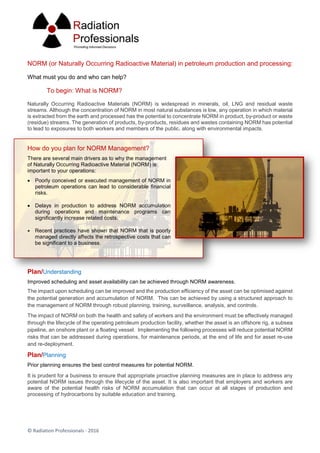More Related Content
Similar to NORM_Plan (20)
NORM_Plan
- 1. © Radiation Professionals - 2016
NORM (or Naturally Occurring Radioactive Material) in petroleum production and processing:
What must you do and who can help?
To begin: What is NORM?
Naturally Occurring Radioactive Materials (NORM) is widespread in minerals, oil, LNG and residual waste
streams. Although the concentration of NORM in most natural substances is low, any operation in which material
is extracted from the earth and processed has the potential to concentrate NORM in product, by-product or waste
(residue) streams. The generation of products, by-products, residues and wastes containing NORM has potential
to lead to exposures to both workers and members of the public, along with environmental impacts.
How do you plan for NORM Management?
There are several main drivers as to why the management
of Naturally Occurring Radioactive Material (NORM) is
important to your operations:
Poorly conceived or executed management of NORM in
petroleum operations can lead to considerable financial
risks.
Delays in production to address NORM accumulation
during operations and maintenance programs can
significantly increase related costs.
Recent practices have shown that NORM that is poorly
managed directly affects the retrospective costs that can
be significant to a business.
Plan/Understanding
Improved scheduling and asset availability can be achieved through NORM awareness.
The impact upon scheduling can be improved and the production efficiency of the asset can be optimised against
the potential generation and accumulation of NORM. This can be achieved by using a structured approach to
the management of NORM through robust planning, training, surveillance, analysis, and controls.
The impact of NORM on both the health and safety of workers and the environment must be effectively managed
through the lifecycle of the operating petroleum production facility, whether the asset is an offshore rig, a subsea
pipeline, an onshore plant or a floating vessel. Implementing the following processes will reduce potential NORM
risks that can be addressed during operations, for maintenance periods, at the end of life and for asset re-use
and re-deployment.
Plan/Planning
Prior planning ensures the best control measures for potential NORM.
It is prudent for a business to ensure that appropriate proactive planning measures are in place to address any
potential NORM issues through the lifecycle of the asset. It is also important that employers and workers are
aware of the potential health risks of NORM accumulation that can occur at all stages of production and
processing of hydrocarbons by suitable education and training.
- 2. © Radiation Professionals - 2016
Plan/Training
Knowledge and understanding to maintain safety, compliance and optimised processes
Ensuring that site-based personnel are competent and qualified to identify NORM accumulation, the local
radioactivity and the considerations for safe working procedures, planning support and compliance is essential.
Their training and mentoring to do so specific to your project is crucial.
Plan/Monitoring
Keep up to date with NORM locations and levels.
Implementing a robust surveillance system for NORM generation through effective detection and monitoring, will
ensure that workers and the environment are protected in accordance with legislation and regulations. This will
identify when and what measures need to be put in place and will provide informed decisions in terms of the
NORM management of the asset.
Plan/Safety
Know where workers can be exposed to NORM and how to prevent hazards to health and safety.
There are two ways that workers may be exposed to NORM. The first of these is external gamma radiation from
NORM accumulation within the process plant during normal operations. The second of these is the inhalation or
ingestion of alpha/beta emitting materials that are released during maintenance, repairs or replacement
campaigns, when containment is breached. Implementing adequate controls through radiation monitoring and
planning will effectively manage the NORM risks and therefore mitigate potential radiation exposures for workers
to within legal requirements.
Plan/Waste
Efficient early stage identification and planning for petroleum production and processing waste.
Where the presence of NORM contaminated wastes is found, this is essential to ensure that any wastes are dealt
with in a timely and cost efficient manner.
NORM waste that is generated must be managed throughout the asset’s life and must be appropriately controlled,
stored, the process equipment decontaminated, the waste transported from the asset and waste disposed of in
accordance with legal requirements.
An outline strategy for NORM management of an operating petroleum facility is available to review by contacting
Radiation Professionals
Colin Lynch
General Manager - Business Improvement
Level 1, 46 Hill Street, East Perth WA 6004
PO Box 3231 East Perth WA 6892
T +61 (0) 8 9325 7679 M +61 (0) 457 324 050
E clynch@radsafe.com.au W www.radiationprofessionals.com

